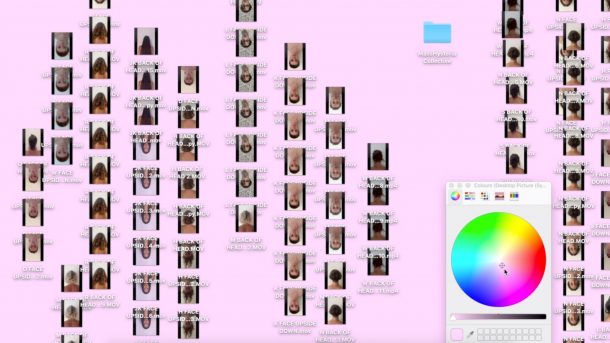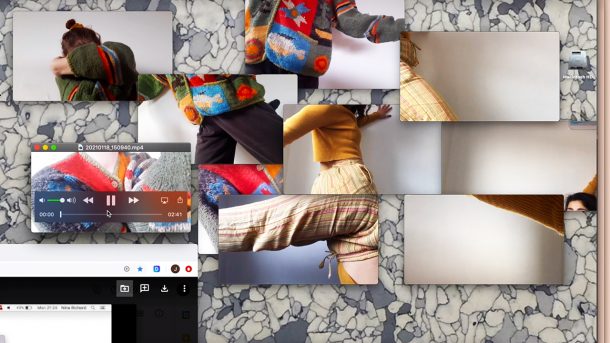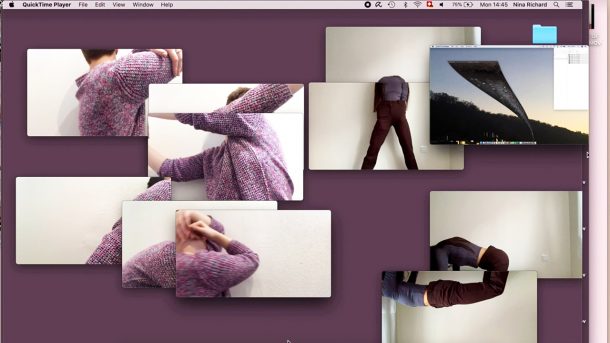For February’s Friday Late we caught up with Jennie Boultbee, Nina Richard and Monika Błaszczak from MassHysteria – an experimental all-female collective of 12 international dance artists. This month they present mh4v&a_1.prologue – a choreography piece for the desktop which examines the relationship between audience and performer, and how this can be reinvented in the virtual world.
Can you tell us a bit about yourselves and your practice?
Nina: We all met during our studies at Trinity Laban Conservatoire in London and formed MassHysteria during our second year in 2017. As a collective we’re 12 female dancers, and in terms of dance we come from various backgrounds. We’re super interested in making transdisciplinary work for the stage, gallery or digital spaces.
Jennie: The majority of us didn’t go to Trinity Laban directly from school, so we not only had other dance experiences, but also other life experiences, or had studied something else before – for example music, or visual arts. A few of us had a background in ballet, some in more community dance-based things, and some with more contemporary experience.
How did MassHysteria come together?
Nina: I think it was one choreography assignment where Monika proposed a work that was somehow in-between writing, listening practice, and improvising. First it was a piece for one dancer, but then we started to explore it with different dancers and met up more often to listen to sounds, write, and then improvise. After that it developed into a collaboration with a composer from the music department who was interested in our practice, and then the pieces came together.

You’re a collective – how does that work?
Jennie: It’s something that we’re always figuring out, I think! Especially how we work together when we’re not together and having to work in this digital world. But in general, there’s no hierarchy, and the constant shifting of roles is important.
Nina: One thing that’s super important to us and also why we call ourselves a collective, is everybody’s input. Be it creative, administrative – in whatever way – it’s equally valued.
Can you tell us more about the experimental nature of your work?
Jennie: I guess it maybe appears experimental because we’re not afraid to try new things and experiment with new mediums. Also, I think the nature of us being a whole multitude of artistic visions and working in different processes and with the different creative outputs which we bring to MassHysteria – all of this together produces work which isn’t what people would expect maybe. Our work is always changing and transforming.
How has the pandemic impacted on your practice?
Nina: One thing for sure was that it became much more digital in terms of our meetings. But it’s valuable because it gave us this drive to really try things out. Of course, it has been difficult, but it has also pushed us in a positive direction – we really did a lot!
Can you walk us through your creative process and how this piece came to life?
Nina: This piece specifically started with another piece we made previously which centred around how choreography works in the digital space, and how we imagine that. Rather than imitating or recreating the conditions of a live performance, we wanted to make use of the thing that is ‘the digital’, and this idea of choreographing the desktop came up. We started to play around with how we could invite our audience to see the desktop dancing, and how we could make the video footage from the different members of the collective a bit secondary – so the desktop is the stage and the folders or files were like the bodies moving. It’s like we’re DJing the screen.

This piece might feel quite abstract for people that haven’t seen anything like it before. What would you say that it represents or conveys?
Jennie: It’s hard to say, because actually it’s coming more from the process or the idea behind it, rather than that we’re trying to share a message necessarily. My personal response would be that it is whatever a viewer sees inside it, or whatever it means to them – whether it’s a reflection of what choreography and dance is in this period, or our preoccupation with the screen, or us trying to bring some of the life into the screen – it can be a multitude of things really.
Nina: I see it as an invitation for an audience to perceive something playful happening on their desktop. That’s at least what I experienced when making. The word ‘playful’ is very important for me in this process – just trying things out and seeing your desktop dance!
Why did you choose to call the piece mh4v&a_1.prologue?
The last piece we made had a title from the order of the clips we used, with .mov at the end. As we’d spent so long staring at the files, this just somehow came out! So the title for this piece is inspired by that a bit – mh4v&a_1.prologue – as we see this as the beginning to the other piece.

Can you tell us about the music?
Monika: I’ve used the track that was made for the previous piece, and have remixed it, transformed it, and made a different thing out of it. The focus has been on making the quality of the sound sharp, electronic, and very intense. I would say a little bit of it is also paying tribute to the artist SOPHIE, who I kept in mind whilst making new work. I think that SOPHIE’s unexpected death reminded me of how important it is to make experimental work and to radicalise ourselves as female and queer bodies, as well as artists.
What is the significance of the female body being tied to virtual in your work?
Monika: It seems important to occupy the internet and digital spaces, as female bodies and queer bodies, fighting for space and visibility and putting our own rules to the game. A little bit of a feminist action, I guess.
How did you find creating this for the V&A’s Friday Late?
Nina: It was a lot of fun, and once we started on this work we almost couldn’t stop. Jennie and I spent hours and hours in front of the desktop trying out new things and had square eyes afterwards! It was really cool and very inspiring. From doing the previous work that was already going in this direction, it was super exciting to see that we could develop it further and find new ways of entering and exiting spaces and the desktop.
Stay tuned for the next Friday Late. Keep up to date by joining our mailing list.


